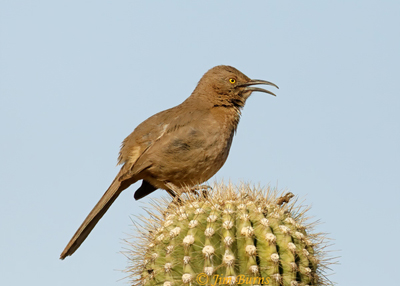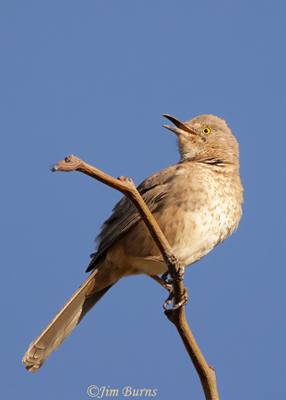
I always think of this exchange when I hear a birder lamenting over how bad they are at birding by ear. I admit I am not a very good “ear birder” myself, but think about all the visual clues you pick up by observing a speaker’s demeanor and facial expressions as they talk. Are they happy or sad, excited or calm, how do they emphasize key words or phrases? “Watching every move on her face” was a trenchant line in a pop song.
Call it facial recognition or personality nuance, but even if a birder is not “musically inclined,” I believe watching a species sing, or even voice short call notes, can be a great tool for learning, remembering, and calling up the bird’s song in your head for future reference when the singer is unseen. Two incidents this past spring helped, again, to prove this to my untrained musical ear.
We have Curve-billed Thrashers in our neighborhood, and this year they nested in our front yard Olive tree. We saw the pair every day as they vocalized in every situation as varied as staying in contact, foraging for food, and issuing alarms when a raptor flew over. When I watch a Curve-billed sing, not call using the “wolf whistle,” but actually singing, the bird looks intent, alert, focused, on a musical mission as it were. The song, correspondingly, is loud and hurried, melodic phrases with trills and whistles.
So, one day birding at a desert park I heard a long, melodic song reminiscent of our Curve-billeds, but softer, slower, more jumbled and slurred. Determined to track it down, which I would encourage all birders to do to improve their ear birding, I came across a thrasher high in a tree, breast spotting distinct, lower mandible straight and light at its base. Bendire’s!
I watched it singing for fully five minutes. Compared to its curve-billed congener, this bird looked calm and relaxed like it was just practicing and didn’t really care whether anyone heard it or not, and it seemed to me its demeanor as it vocalized matched the pitch and cadence of the song itself. Of course other listeners will have their own adjectives and mnemonics for the differences in songs of these two thrashers, but the point is they are different and can be learned with enough observation and practice.
The punchline for this story is that at the time I had very few good photos of Bendire’s Thrasher and, later, I also saw Curve-billeds in the same park. Returning the following week, camera ready, I heard and immediately recognized a Bendire’s singing as I got out of my car. I tracked it down and finally shot some good images of this species, a much less common bird than Curve-billed.
Although I never actually seek out Curve-billed Thrashers in Arizona, I probably see one (or two) several times during a typical birding week. I had not seen a Bendire’s Thrasher in several years despite looking specifically for the species on more than a few birding trips. Sooner or later I will lose my new found familiarity with Bendire’s song, but because I have actually seen it singing, I’d guess I’m going to be good for it, aurally, for a couple years. Listen with your eyes!